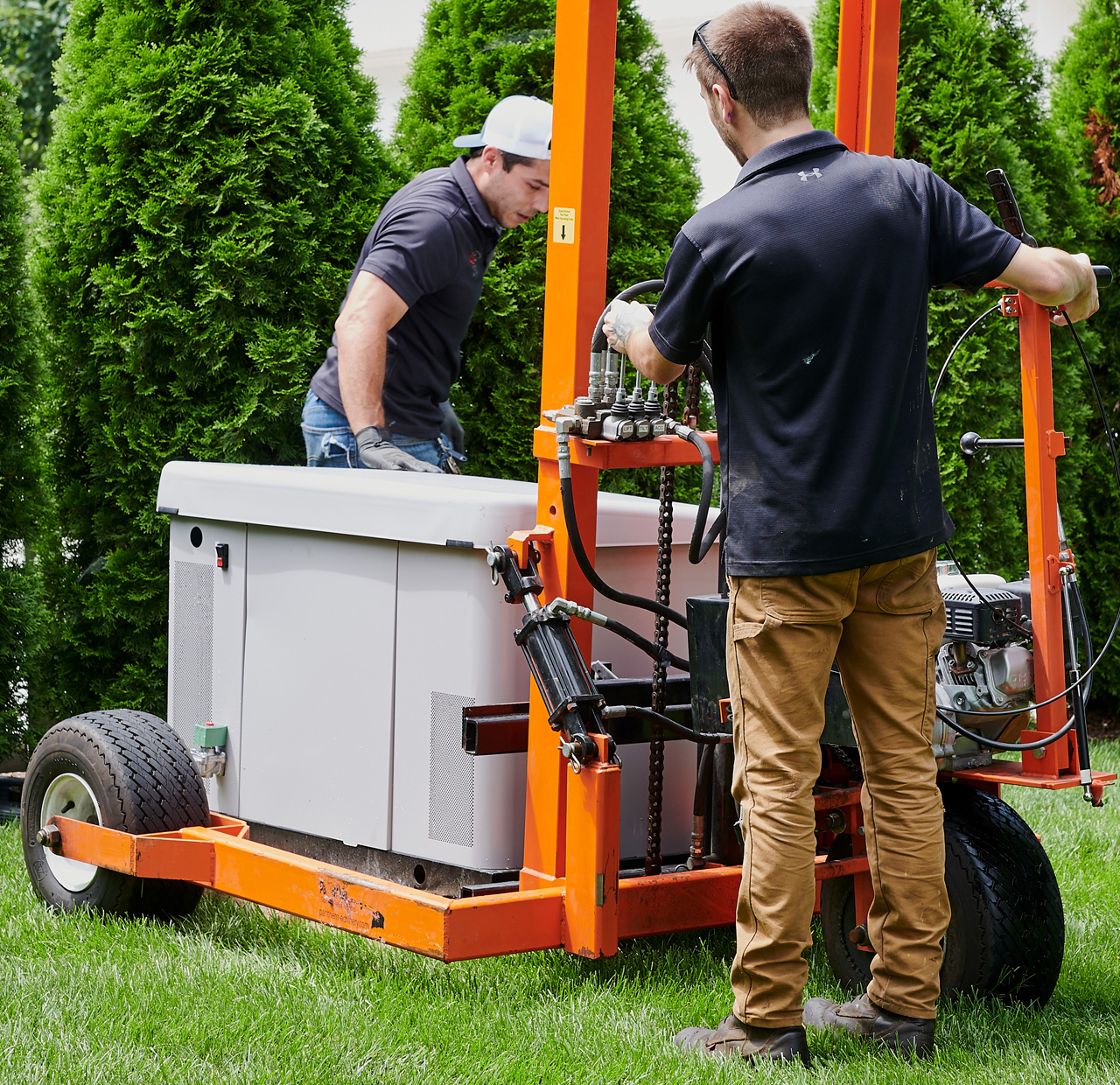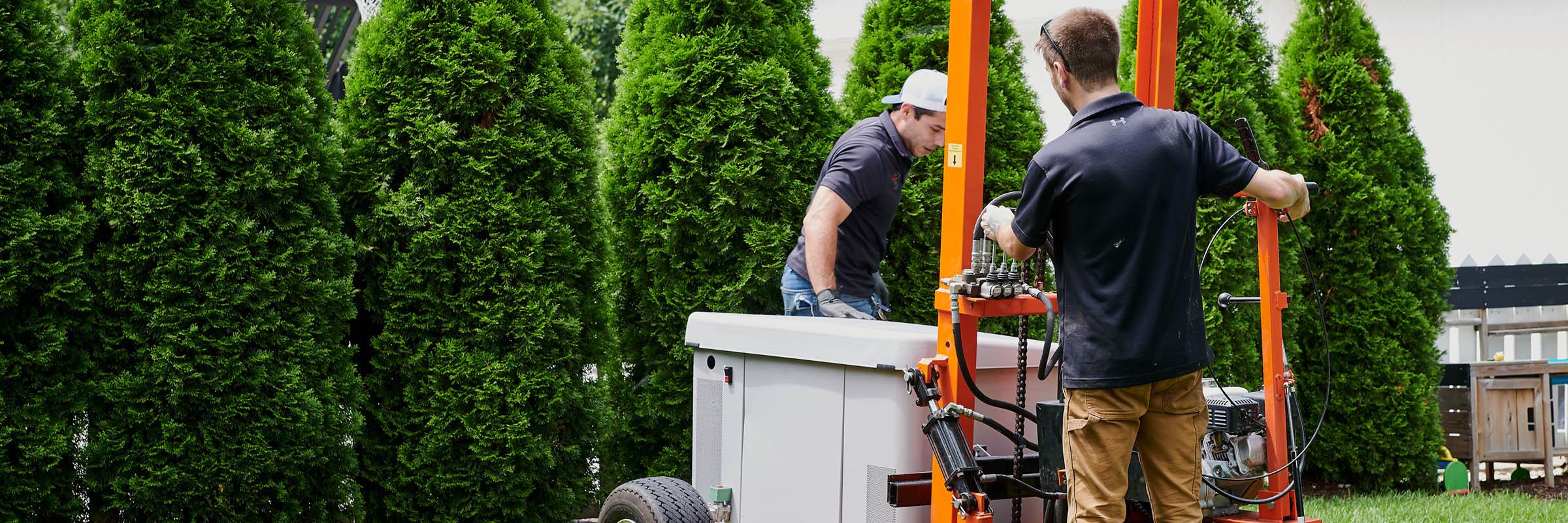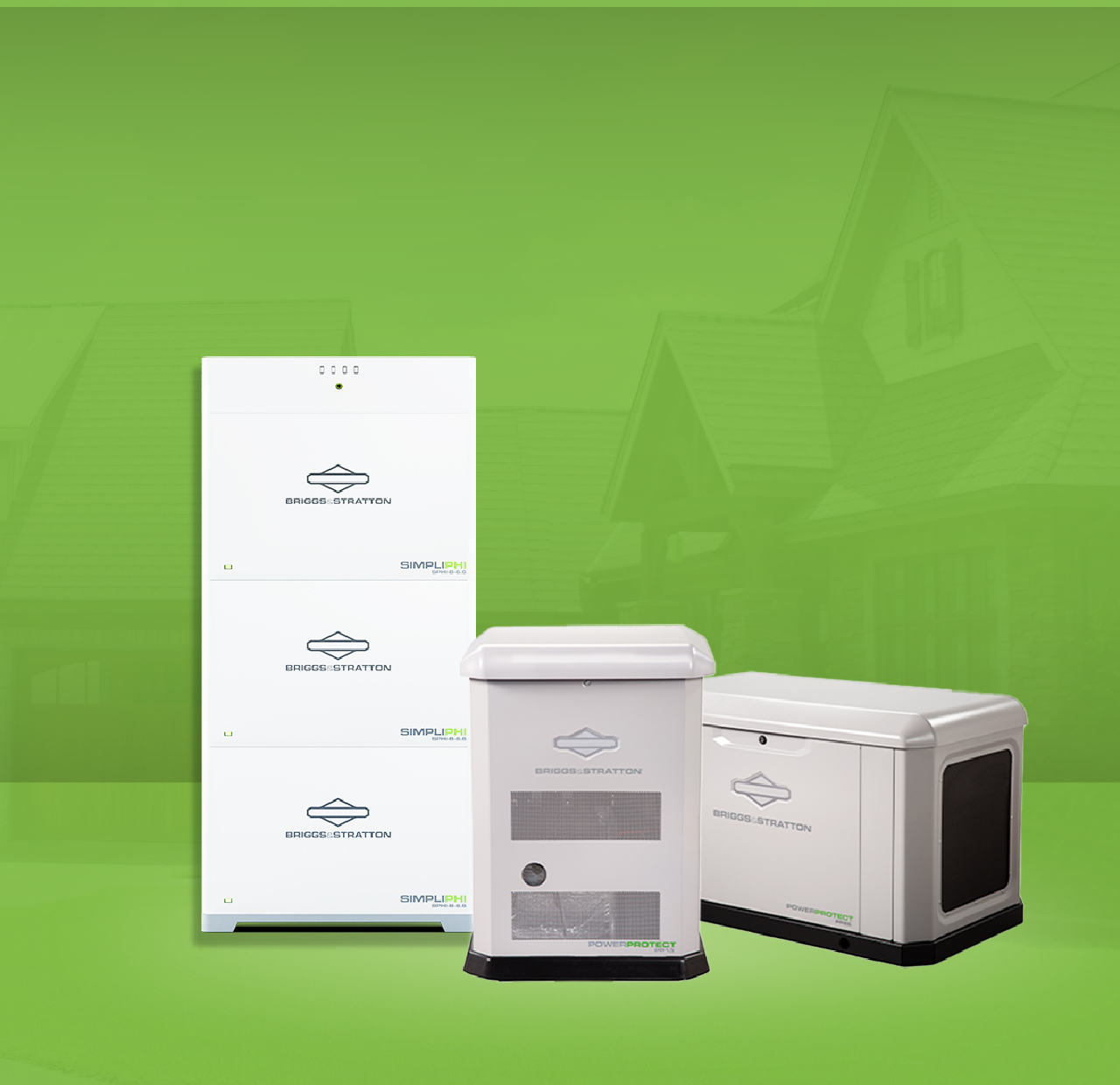

Technical FAQs
Answers to commonly asked questions.
With energy storage comes peace of mind and security during a blackout, as well as cost savings every other day of the year.
With extreme weather events, wildfires and other threats to energy security becoming more frequent, Briggs & Stratton battery storage can provide peace of mind. With our modular and scalable design, battery banks can be designed to power your entire home or just the appliances and communication devices you consider critical in the event of a power outage. When the grid is unavailable, you can still have all the power you need.
All over the world, generators are used as back up power for homes. But the truth is, during catastrophic events, propane or diesel is often in short supply and expensive. Combining batteries with your generator can create fuel savings and extend your available reserves, as well as cut down on environmental and noise pollution. Briggs & Stratton's turn-key residential batter storage solutions such as the PHI, AmpliPHI, and SimpliPHI 6.6 have a built-in automatic generator start (AGS) to optimize your generator's performance with grid and/or PHI battery power.
If your home PV system is connected to the grid, you will lose access to all your electrical generation during a power outage. Adding Briggs & Stratton battery storage to your solar array stores excess power for you to access during an emergency. Storing excess solar power can also provide a greater return on your renewable energy investment, particularly in regions where utilities have unfavorable rate structures, such as demand and time of use charges. Our batteries also allow you to draw from your storage for power at night and during times of inclement weather. Combining solar plus storage allows you to generate and consume your own power on demand, rather than relying solely on the utility.
In many locations, utilities have:
Homeowners who are on a time-of use-rate or an electric vehicle rate, can charge Briggs & Stratton PHI batteries when energy is cheaper (for example, at night) and discharge energy when energy is more expensive. By enabling homeowners to shift their use of grid electricity to less expensive times, our battery storage solutions can significantly reduce utility bills.
In today’s energy environment, businesses from Main Street to Wall Street must contend with an ever-present and increasing number of threats to maintaining a reliable power supply, making disaster preparedness and recovery plans critical.
According to ITIC’s 2017 Reliability and Hourly Cost of Downtime Trends Survey on average, each hour of downtime costs a company more than $100,000, while 81% of organizations report that the cost exceeds $300,000. Beyond those averages, one-third of companies say an hour of downtime costs them $1 million or more.
Briggs & Stratton Energy Solutions helps prevent companies from losing vital revenue due to grid outages that undermine mission-critical systems, equipment, servers, networks, payment systems, communications and more. Our energy storage solutions keep your business up and running and safeguard against energy-related losses.
With a proven global track record of successful grid-tied and off-grid projects since 2010, we have the expertise and experience to design reliable backup and emergency power systems that protect your operations when power is intermittent or completely unavailable.
Briggs & Stratton battery storage systems offset utility rates by reducing power usage during peak hours and shifting usage from peak to non-peak hours. As a result, businesses are able to avoid spikes in energy use and high demand charges that can account for more than 50% of every electric bill and save hundreds of thousands per year.
Demand charges are calculated based on the highest 15-minute average electrical use recorded in one month. Demand charges make up a significant percentage of all commercial and industrial utility bills - typically between 30 and 70 percent. Demand charges continue to increase, while overall energy prices are decreasing. Briggs & Stratton Energy Solutions can help protect your business from incurring these demand charges.
Save space and simplify installation with Briggs & Stratton Energy Solutions. Our batteries are not only energy-dense and compact, but they also feature an inherently safe, non-toxic Lithium Iron Phosphate (LFP) chemistry. This advanced chemistry eliminates the fire risk associated with other lithium-ion technologies, removing the need for space-intensive cooling, ventilation, or thermal monitoring systems. As a result, our energy storage solutions offer the flexibility to be installed in small, convenient locations, including a cabinet or utility closet.
Depending on your power needs, our modular energy storage solutions can scale to meet any demand, and grow over time as your power requirements increase. Adding more batteries to an existing installation is simple and cost-effective.
Our batteries are engineered for safety using a cobalt-free, Lithium Iron Phosphate (LFP) chemistry. This advanced chemistry is inherently stable and not susceptible to thermal runaway, which prevents the risk of fire. Additionally, the materials are non-toxic and environmentally benign.
This technology's safety has been proven in the most extreme conditions. During the 2017 California wildfires, commercial customers using systems with this exact LFP chemistry (then under the SimpliPhi Power brand) were grateful that their batteries did not cause any fires or add to the danger.
We have expertise working with schools worldwide for both on- and off-grid energy storage and management solutions. Schools seek out Briggs & Stratton Energy Solutions' batteries because they offer a safer, non-toxic lithium-ion alternative that doesn’t put students or academic facilities at risk. Our small, scalable footprint does not require cooling or ventilation, allowing storage to be installed in tight indoor or outdoor locations on campuses where space and safety are at a premium.
School districts can achieve significant cost savings when they install energy storage to offset peak usage. This “peak shaving” capitalizes on schools’ predictable electrical load profile, where usage peaks during mid-day and drops when students and faculty head home. With energy storage, batteries can charge during off-peak hours and discharge to offset energy use during these peak times. As a result, schools are able to avoid spikes in energy use and high demand charges that can account for more than 50% of their electric bill and save them hundreds of thousands of dollars per year. We’re thrilled to help our education partners pay less for electricity and preserve more financial resources for their education budget.
Whether a school district is seeking to upgrade heating and cooling systems or make comprehensive energy efficiency improvements, the price tag can be daunting. Did you know that in many cases, installing a solar+storage microgrid to power new equipment can prove far less costly than funding comprehensive infrastructure upgrades normally required to power such new equipment? For example, in 2016, in response to a $1.6 billion campus statewide air conditioning installation budget shortfall, the Hawaii Department of Education found a game-changing solution in microgrids. The capital cost of implementing roof-top PV+SimpliPhi storage microgrids together with split system A/C units to cool classrooms proved to be substantially lower than traditional grid-tied central air conditioning systems. This approach reduced the budget to $140 million. Plus, having on-site energy storage and flexibility in programming the power electronics allowed schools to keep their current energy costs and energy access stable while maintaining grid-connection for backup power.
Not all lithium-ion batteries are the same—their core chemistry makes a critical difference. Many common lithium-ion batteries contain cobalt, an unstable and toxic element. This is the material responsible for "thermal runaway," the dangerous overheating reaction that has caused fires in products like cell phones, laptops, and even large-scale energy systems.
Briggs & Stratton takes a safer approach. We exclusively use a cobalt-free chemistry called Lithium Iron Phosphate (LFP). LFP chemistry is inherently stable, non-toxic, and environmentally benign, eliminating the risk of thermal runaway and ensuring our batteries are one of the safest, most reliable solutions available.
Briggs & Stratton batteries feature a compact, space-saving design. Because they do not require external ventilation, cooling, or thermal monitoring equipment, they can be safely installed in tight spaces like a closet or utility room. This flexibility is enhanced by a wide operating temperature range of -4°F to 140°F, allowing for reliable performance whether the batteries are installed indoors or outdoors to best suit the building's layout.
Energy resilience is important to any business, but hospitals and other medical facilities are especially vulnerable to power outages. When the power grid goes down, energy storage can ensure uninterrupted patient care and operations by securing life-saving medical equipment and data centers. Briggs & Stratton batteries allow hospitals and other healthcare facilities to self-sufficiently operate safely and reliably during power outages or in remote locations beyond the grid, without any downtime or unnecessary risk.
Our lithium-ion batteries are safe for a hospital environment. Not all lithium-ion batteries are the same. In fact, there are a variety of different lithium-ion chemistries, many of which utilize cobalt, which makes them unstable, toxic, and unsuitable for medical environments. Briggs & Stratton battery storage solutions use lithium ferrous phosphate (LFP) to create batteries that are environmentally benign, non-toxic and do not pose any risk. Without the danger of fire or toxicity, our batteries are the ideal choice for hospitals.
Space is often at a premium in medical facilities. Our batteries have a very small footprint. This energy density, scalability and the fact that our batteries do not require ventilation, ancillary cooling or thermal monitoring equipment translates into higher efficiencies and smaller installations - even in closets or utility rooms. In addition, because the batteries can operate safely in temperatures from -4° to 140°F, Briggs & Stratton battery storage can be installed indoors or outdoors.
Hospitals often use more energy than virtually any other type of commercial facility. Open 24-hours-a-day to thousands of employees, patients, and visitors, with sophisticated heating, ventilation, and air conditioning systems and a wide range of energy intensive activities such as laundry, medical and lab equipment, sterilization, computers, food service, and refrigeration, hospital electricity costs represent a significant drain on financial resources and diverting dollars from critical care. Briggs & Stratton Energy Solutions can help offset the costs of all that power and restore much needed funds to the operating budget. With PHI batteries, medical facilities can charge during off-peak hours and discharge to support electrical loads during peak rate periods. As a result, medical facilities are able to avoid spikes in utility rates as a result of high demand charges.
First rate hospitality means you never have to be without power. Our energy storage solutions transform hotel and resort operations around the world - from major metropolitan areas to remote, off-grid paradise locations.
A growing number of hotels and resort properties are generating some or all of their electricity on-site with solar PV or other renewable energy installations. Our energy storage solutions enable hotels and resorts to take renewable energy one step further by storing excess energy for use at night or during prolonged inclement weather. We also eliminates the unpredictability and intermittency often associated with renewable energy supply. Plus, in grid-tied locations, pairing behind-the-meter energy storage with renewable generation can double energy savings.
With Briggs & Straton Energy Solutions, hotels can charge batteries when the cost of energy is less expensive and access that reserve to offset costs when electricity demand and rates spike, such as guests turning on their air conditioners on a hot day or when they return to their room in the evening. By limiting a hotel’s need to rely on grid power when it’s likely most expensive and reducing short-term usage spikes, we're able to help hotels reduce their exposure to significant peak demand charges, which can account for as much as 50 percent of their utility bill.
For resorts in remote vacation spots, our expertise in solar+storage microgrids ensures that your hospitality business will have ample electricity 24x7 electricity to deliver a world-class guest experience with little or no diesel generation. Because our batteries are non-toxic, they empower resort properties to sustainably reduce energy costs and mitigate any negative environmental impacts to areas surrounding lodging facilities.
When comparing lithium-ion storage alternatives, the element to avoid is cobalt. Our cobalt-free lithium ferrous phosphate (LFP) chemistry is environmentally benign, non-toxic and does not pose a danger of thermal runaway. Without the threat of fire danger or toxicity, our batteries are safe for hotel guests and your property.
A report published in October 2017 by a team from the School of Global Policy and Strategy at the University of California San Diego found that fast-food restaurants realize the highest internal rate of return on an energy storage investment. Though the study focused on fast food and on restaurant operations in Florida, the findings provide important insight for all restaurant and food service business owners about the economic business case for storage.
Restaurants incur significant peak demand charges due to predictable and intense periods of energy use during the breakfast, lunch and dinner hours. This usage pattern and its predictability creates a robust opportunity to leverage energy storage to offset that peak demand, which often accounts for as much as 50% of a restaurant's utility bill. With Briggs & Stratton energy storage and management solutions, restaurants can store energy when it’s least expensive and access that reserve during peak times of use, reducing demand charges.
When purchasing energy storage, foodservice operations need a solution that does not pose a danger of food contamination, fire or other risks to their property or their patrons. Because Briggs & Stratton batteries do not contain hazardous cobalt, they are the perfect choice for restaurant environments. Our lithium ferrous phosphate (LFP) lithium ion chemistry is environmentally benign, non-toxic and does not pose a danger of thermal runaway.
We work with growers, processors, wineries, cold storage facilities, packers, nurseries, and a wide range of other agriculture entities to deliver energy savings and security. Whether you are looking to optimize high-energy-use processes like irrigation, ensure backup power and total resiliency for a cold storage facility, reduce general operating expenses, or simply farm more sustainably, we can help.
Briggs & Stratton batteries have a very small footprint. Their energy density combined with the fact that they do not require ventilation, ancillary cooling or thermal monitoring means our batteries can be installed in tight spaces, such as closets or utility rooms. In addition, because our batteries can operate safely in temperatures from -4° to 140°F, they can be installed indoors or outdoors. This versatility allows you to choose to install container-type storage or in existing barns, warehouses or other buildings.
Briggs & Stratton Energy Solutions is able to store electricity from solar and wind turbines (DC input), conventional generators, or the grid. Given that renewable sources of power can be intermittent and unpredictable without energy storage, adding our batteries to your renewable generation plant will allow you to have true power security and resilience. In addition, in grid-tied locations, an integrated solar PV or wind turbine combined with an energy storage system can maximize your utility bill savings - both reducing energy and demand charges.
With Briggs & Stratton Energy Solutions, agricultural operations can either capture energy created through renewable generation and store it, or store energy from the grid during off peak hours when prices are low and discharging it during peak rate times. By limiting your need to rely on grid power and reducing short-term usage spikes, Briggs & Stratton is able to help agricultural customers reduce their exposure to significant peak demand charges, which can account for as much as 50 percent of a utility bill.
When it comes to lithium-ion batteries, cobalt is an element that is toxic and poses the risk of thermal runaway and fire. We do not use cobalt. Our lithium-ion chemistry is lithium ferrous phosphate (LFP) which is environmentally benign and non-toxic. Without any danger of overheating or toxicity, our batteries do not pose a risk of fire or contamination of crops, animals or processed food products.
Our energy storage solutions are ideally suited to provide power for remote test centers, data stations, scientific sites, oil rigs and mining operations. Our microgrid expertise helps companies and government agencies power the full range of remote off-grid facilities, safely and reliably. Plus, our plug-and-play containerized solutions make on-site deployments fast and easy.
Many of our customers have previously deployed diesel generators as a way to extend access to power beyond the grid, and have turned to energy storage to significantly reduce fossil fuel usage the cost of transporting fuel. Typically, replacement systems are designed to run on solar + storage with a diesel generator for backup during inclement weather. With a microgrid system, generators are downsized and used only as backup power to charge the batteries when needed, lowering costs and reducing noise and pollution.
Briggs & Stratton ruggedized batteries are able to withstand a wide temperature range -- from -4° to 140°F - without any risk of thermal runaway, failure or fire. In fact, our batteries have been proven in desert combat zones on forward operating bases by the U.S. Army and Marine Corps.
With more than 1,000 cancelled flights and an estimated $50 million in losses by Delta alone, the December 2017 power outage at Hartsfield-Jackson Atlanta International Airport emphasized the need for airports to find more reliable ways to power their energy intensive operations. Microgrids featuring Briggs & stratton batteries provide airports with the means to produce, store and distribute power to a single terminal or an entire airport complex, either as its main source of power or as its auxiliary electricity supply in the event the grid goes down.
Yes. Renewable sources of power can be intermittent and unpredictable. Adding Briggs & Stratton batteries to your existing renewable installation removes the risk of intermittency and allows airports to have true power security. Our energy storage solutions can store electricity from solar and wind chargers (DC input), conventional generators, or the grid. In addition, in grid-tied locations, an integrated solar PV or wind turbine + battery storage can reduce both energy charges and demand charges and maximize your utility bill savings.
Briggs & Stratton lithium ion chemistry is safe because it does not contain cobalt. Cobalt is the element that causes phones, laptops and other battery-powered devices to heat up and catch fire. SimpliPhi’s cobalt-free lithium ferrous phosphate (LFP) lithium ion chemistry is environmentally benign, non-toxic and does not pose a danger of thermal runaway and is non-toxic. In fact, because of the safety record we achieved through years of deployments with U.S. military the FAA granted us "Special Permission" to transport batteries globally via air.
Briggs & Stratton battery storage solutions are modular and scalable and can be sized to provide critical power for base loads, peak loads and days or weeks of energy autonomy.
For large airports, daily electricity usage is equivalent to that of a city of 100,000 people - comprising as much as 10% to 15% of a airport’s operating budget. Briggs & Stratton energy storage can help offset those electricity costs by allowing airports to charge batteries during off-peak hours and to discharge batteries during peak times to offset energy costs. As a result, airports are able to avoid spikes in energy use and high demand charges and subsequently pay less for energy.
By installing a Briggs & Stratton energy storage solution, airports can avoid the cost and disruption of trenching through airfields to bring in new power lines. In addition, based on battery airport deployment experience, microgrids are not only more cost effective, they also reduce project timelines.


Complete the form below for a no-obligation estimate.